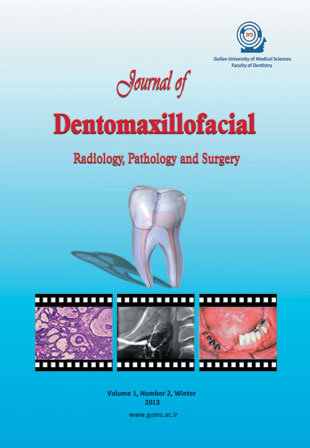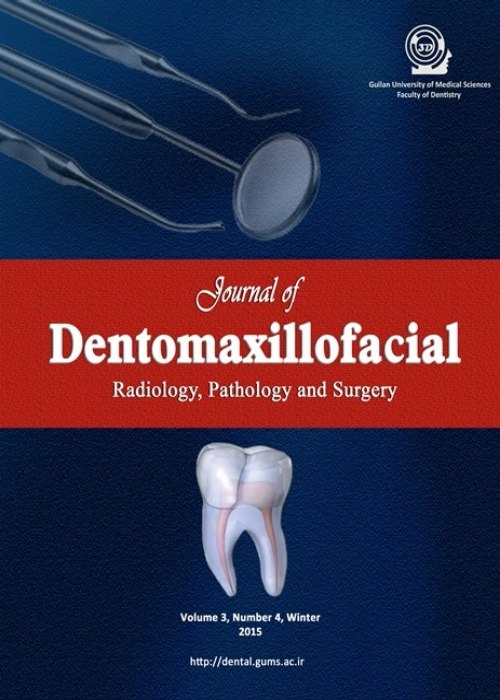فهرست مطالب

Journal of Dentomaxillofacil Radiology, Pathology and Surgery
Volume:1 Issue: 2, Winter 2013
- تاریخ انتشار: 1391/11/15
- تعداد عناوین: 7
-
-
In vitro Comparison of Conventional Film and Direct Digital Radiography in Proximal Caries DetectionPage 1IntroductionVarious systems for intraoral digital radiography have been available as an alternative to film–based radiography. In consideration of several advantages of digital radiography such as less patient absorbed dose, manipulation of im¬age quality and elimination of processing, it has been extensively used in different fields of denti¬stry in recent years. The purpose of this study was comparison of conventional film and digital radiography in the proximal caries diagnosis.Materials And MethodsIn this in vitro study, 60 extracted premolar teeth were selected and mounted in acrylic blocks. The teeth were radio-graphed using F-speed film and a complementary metal oxide semiconductor digital sensor (CMOS). Two observers evaluated interproximal surfaces for detection of presence and extent of caries. True caries depth was determined by his¬tological examination. The diagnostic accuracy of each radiographic system were assessed by means of receiver operating characteristic curve (ROC) analysis.ResultsThere was no significant difference be-tween two imaging modalities. The AZ values in cases without caries and dentinal caries were greater than caries restricted to enamel and Den¬tino Enamel Junction (DEJ). The differences among observers also were not statistically sig-nificant.ConclusionBoth imaging modalities were com-parable in the detection of proximal carious le-sions.Keywords: Dental caries •Dental, Radiography, Digital •Film
-
Page 6IntroductionThe aim of this study was to eva-luate the salivation flow rate objectively using Schirmer test; and mouth dryness and other con¬sequences subjectively by distributing question¬naires to patients receiving head and neck radio¬therapy.Materials And MethodsIn this descriptive study that was carried out at Imam Khomeini hospital, Tehran, Iran, the saliva flow rate of 33 patients receiving radiotherapy was evaluated in millimeter in 5 minutes using Schirmer test (with a filtered paper calibrated from 1 to 35mm) before treatment, two weeks and four weeks after and at the end of treatment thus having four groups of measurements. Mouth dryness and other consequences were recorded by questionnaire at final stage. Friedman test, chi- square, dependent and independent t-tests were applied to analyze the data.ResultsIn all four groups, the mean of the saliva flow rate decrease during treatment was significant and followed a descending pattern. At the end of the treatment, the total received dosage and saliva flow rate had an inverse relationship, (P value=0.000). The mean salivation decrease in bilateral radiation was estimated more than unilateral one; though their relation was not statistically significant (P value=0.251). The mean salivation decrease in bilateral radiation of nasopharyngeal cancer was meaningfully greater than unilateral (P value 0.05).ConclusionDuring radiation, saliva flow rate depends on the total dosage and the radiation site. Increasing the total dosage of radiation and the field diameter would result in the decrease of salivation of the major salivary glands, particularly parotid ones.Keywords: Radiotherapy •Salivary Glands •Xerostomia
-
Page 13IntroductionThe purpose of this in-vitro study was to compare shaping ability of NiTi rotary Mtwo and FlexMaster with stainless steel hand K-Flexofile in curved root canals of extracted teeth.Materials And MethodsMesiobuccal canals of 45 mandibular molar teeth were balanced into three groups of 15 each, with respect to the Schneider angle, canal access angle, height, dis-tance and radius of canal Curvature. Canals were prepared with Mtwo, FlexMaster and stainless steel hand K-Flexofile according to the manufac-turers` instruction. Comparing pre- and post-instrumentation radiographs, straightening of the canal curvatures was determined using AutoCAD program. Data was analyzed using one way ANOVA and Tukey HSD test.ResultsAfter instrumentation, the K-Flexofile system was significantly different from Mtwo and Flex Master systems for the mean difference of Schneider angle (p=0.0001, p=0.0001), canal access angle (p=0.006, p=0.003), radius (p=0.045, p=0.015) and distance of curvature (p=0.001, p=0.001).ConclusionMtwo and FlexMaster files main-tained the original canal curvatures better than the K-FlexofileKeywords: Root canal preparation • Dental instruments
-
Page 18IntroductionIrrational drug prescription is a controversial issue around the world that inter-feres not only with the patient's life but also with the society and economy. Despite few studies, there is no enough data on the prescription ha¬bits of dental practitioners. So, we aimed at eva¬luating the same issue in Rasht, Iran.Materials And MethodsThis cross-sectional re-trospective study; reviewing a convenience sam-ple of 850 dental prescriptions selected randomly from social insurance prescriptions; assessed for two parameters: The first for WHO drug indica¬tors such as the mean number of drugs per pre¬scription, the percentage of durgs with generic name, the percentage of prescription with anti¬biotics and injectives, and the second for the pre¬scription errors. Chi-sqaure test was used for analyzing the data.ResultThe average number of drugs per pre-scription was 2.64±0.85. Drugs with generic names constituted 82.9%. 93.8% of prescriptions had at least one antibiotic, whereas 26% had in-jectives. Combination of antibiotics and NSAIDS (Non-steroidal anti-inflammatory drugs) were the most common prescribed drugs. The mistakes related to drug form, name, quantity, dose, dose interval as well as route of administration were 18.4%, 22.5%, 16.5%, 14%, 39.6%, 94.9% respec¬tively. Average number of drugs, percentage of antibiotics and injectives per prescriptions, mis¬takes in drug quantity, dose interval and route of administration were lower in prescriptions of fe¬male prescribers than in males.ConclusionPolypharmacy, overuse of antibio-tics and prescription errors among the prescrip-tions of dental practitioners were common. Conti¬nuous training of dentists would be necessary to improve the quality of prescriptions.Keywords: Dentists •Drug •Prescription
-
Page 24IntroductionMany epidemiological studies have been conducted to determine the prevalence of the various types of the dental anomalies. The aim of the present study was determination of developmental and acquired dental anomalies in patients attending the faculty of dentistry in Rasht, Iran.Materials And MethodsIn this retrospective cross-sectional study, 1224 digital panoramic ra-diographs belong to 758 females and 466 males were assessed for evaluation of 10 developmen-tal and acquired dental anomalies. This study was done in two steps; prospective and retrospective. Both clinical and radiographic evaluation of pa¬tients was conducted for diagnosis of missing teeth, talon cusp, amelogenesis imperfecta, den¬tinogenesis imperfecta and dentine dysplasia. The chi-square test, Fisher-Exact test, Indepen¬dent t-test and Kappa were used for statistical analysis of data.Result396 patients (32.4%) presented at least one developmental dental anomaly and 285 pa-tients (23.3%) had at least one acquired dental anomaly. Overall, 38.1% of 581 patients with dental anomaly were males and 61.9% of them females. Supernumerary teeth in males was more than five times higher than females (p<0.005). Pulp stone in females was 7% higher than males (p<0.005). The most prevalent anomaly was im¬paction (16.6%), followed by dense invagination (10.9%), dilaceration (5.6%), microdontia(3.8%), supernumerary tooth (1.1%), taurodontism(0.5%) and transposition(0.1%).ConclusionThe dental anomalies occur with different frequencies in various populations. Since, these anomalies may be the cause of vari-ous dental problems, it seems that the precise diagnosis of these anomalies is essential in the prevention of the next problems.Keywords: Prevalence•Radiography, Panoramic •Tooth abnormalities
-
Page 33IntroductionPapillon-Lefèvre syndrome(PLS) characterized by palmoplantar hyperkeratosis is a rare autosomal recessive genetic disorder with rapidly progressive periodontitis and premature loss of both deciduous and permanent teeth. In this study, we report the clinical and radiographic features of Papillon-Lefèvre syndrome in an 11- year-old girl and we also discuss the history and various theories about the etiology and treat¬ment planning for this syndrome.Keywords: Keratoderma, Palmoplantar •Papillon, Lefèvre Disease •Periodontitis
-
Page 39IntroductionPanoramic view as a routine dental radiograph has an important role in diagnosis of other facial abnormalities accompanied with dento- alveolar structures. In this case presentation, we discuss this subject and also the efficacy of cone-beam computed tomography in localization of foreign body in complex anatomy of nasal cavity.Keywords: •Cone, beam Computed Tomography •Foreigen Bodies •Nasal Cavity


